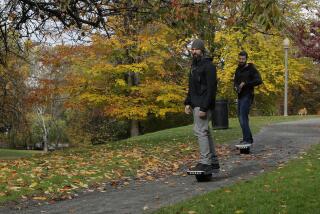Scooter-Related Injuries Nearing 9,500
- Share via
WASHINGTON — They are the fad of the moment, but those sleek, fold-up foot scooters have sent nearly 9,500 Americans, mostly children, to emergency rooms with injuries this year.
The number of scooter-related injuries has surged this summer, with more than 4,000 in August alone, compared with fewer than 500 in May, the Consumer Product Safety Commission said Tuesday. Children younger than 15 account for nearly nine out of the 10 injuries.
“These are certainly not your grandmother’s scooters from the ‘50s,” Ann Brown, the safety commission’s chairwoman, said in an interview. “Many kids are ending up in hospital emergency rooms instead of classrooms.”
The safety commission says it had received reports of 9,411 scooter injuries this year as of Aug. 27. The majority of injuries were cuts, bruises and sprains, but a third were broken bones or dislocations, mostly in the arms and hands. Hospitals treated and released nearly all of those injured. There have been no deaths related to the new scooters.
Dr. Jill Posner, 33, who practices emergency pediatric medicine at Children’s Hospital of Philadelphia, said she saw her first scooter-related injury in June, but more have been coming in over the summer.
“People don’t think about the fact that these scooters can be as dangerous as bikes and skateboards,” Posner said, adding that she’s seen children with serious head injuries who were struck by cars while riding scooters.
The scooters, first widely sold in the United States late last year, are souped-up versions of the kick-powered scooters made popular in the 1950s. Their popularity soared this summer, and the scooter industry expects to sell 2 million to 5 million scooters this year, the commission said. That’s at least a $200-million business, up from virtually zero sales last year.
Brown said nearly two-thirds of the injuries could have been prevented or lessened if the riders had been wearing protective equipment. The safety commission recommends a scooter rider wear the same safety gear suggested for an in-line skater: a helmet, wrist guards and knee and elbow pads. Such equipment can cost less than $35.
But some people doubt the message will sink in.
“No one wears safety gear. I have never seen anyone wear safety gear,” said Kristen Tempel, a George Washington University student who owned an older-style scooter when she was younger.
More to Read
Sign up for Essential California
The most important California stories and recommendations in your inbox every morning.
You may occasionally receive promotional content from the Los Angeles Times.













